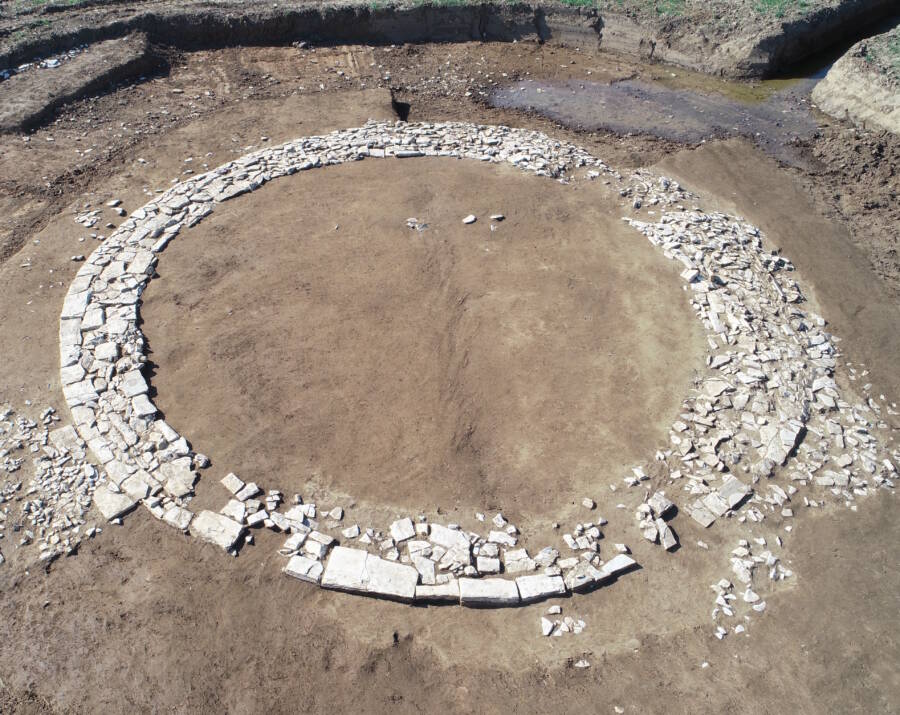Massive Funerary Monument From The Roman Era Unearthed During Construction Work In Germany
Dr. Woidich GmbHThe circular stone structure from the Roman era, believed to be a funerary monument, that was discovered near Wolkertshofen, Germany.Archaeologists have uncovered a rare circular monument in the German state of Bavaria, believed to be the remains of a burial mound from the Roman era.The Bavarian State Office for Monument Preservation discovered the mound while conducting work related to the construction of a new stormwater retention basin in the region. No human remains have been found at the monument, leading archaeologists to conclude that the circular monument may have been built as a cenotaph, symbolic memorial to someone who died elsewhere.The monument once sat near a major Roman road, leading from Nassenfels into the Altmhl Valley. While burial mounds were not uncommon in the Roman world, the particular size and construction of the newly-uncovered monument make it a unique find in the region.The Discovery Of A Roman Funerary Monument During Construction Work In GermanyDr. Woidich GmbHArchaeologists also found a square extension on the south side of the structure that may have served as a base for an altar.The monument was first unearthed last fall after construction began to install a new stormwater retention basin near Wolkertshofen, Germany. Because the region has been known to hold old settlements and burials, the construction project was conducted alongside the Bavarian State Office for Monument Preservation.At first, archaeologists only discovered ceramic fragments and hints of prehistoric settlement in the region. Then, they found the remains of a massive stone foundation.The stone foundation formed a circle just over 39 feet in diameter. It was composed of neatly stacked stones. Archaeologists also located a structure extending about 6 feet out from the monument on the south side of the circle.Archaeologists found no traces of human remains or burial artifacts at the site. This led the team to conclude that the mound was built as a cenotaph, or a symbolic burial mound for someone who died elsewhere and whose body was not present for interment.We didnt expect to discover a funerary monument of this age and scale, Mathias Pfeil, General Conservator at the Bavarian State Office for Monument Preservation, said in a statement. Located along an important Roman road, this tumulus served both as a memorial and a statement of social prestige for the deceaseds family.Based on the material used to create the monument and the way in which it was built, archaeologists estimate it was built sometime during the Roman period. Similar burial mounds appeared in the northwest regions of the Roman Empire during the first century.The Prevalence Of Burial Mounds In The Roman ProvincesDr. Woidich GmbHThe excavation site of the circular Roman burial mound found in Wolkertshofen.At the time the burial mound was constructed, the region was known as the Roman province of Raetia. It extended from modern Switzerland into Liechtenstein, Northern Italy, Austria, and southern Germany.This area had a long history of burial monuments dating back as far as the Bronze Age. By the Iron Age, these mounds were often used for secondary burials.Archaeologists hypothesized that the Roman construction of burial mounds in the region beginning in the first century may have been done as an attempt to return to pre-Roman Celtic traditions.However, the construction of the monument is distinctly Roman. That, combined with its size and preservation, makes the circular mound unique for Raetia.Now, archaeologists are going to analyze soil samples and construction materials in order to determine the monuments approximate age. They also want to figure out if there were any different possible phases of use for the site. Indeed, much more remains to be uncovered regarding this unique find.After reading about the circular monument found in Bavaria, see the circular Mayan temple uncovered in Mexico. Then, learn about a 2,600-year-old burial mound in Germany that was made for a Celtic prince.The post Massive Funerary Monument From The Roman Era Unearthed During Construction Work In Germany appeared first on All That's Interesting.


